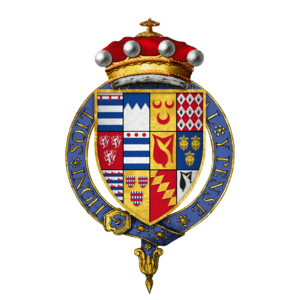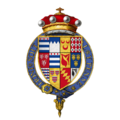Arthur Grey, 14th Baron Grey de Wilton facts for kids
Quick facts for kids
Arthur Grey
|
|
|---|---|
 |
|
| 14th Baron Grey de Wilton | |
| In office 1562–1592 |
|
| Lord Deputy of Ireland | |
| In office 1580–1582 |
|
| Personal details | |
| Born | 1536 |
| Died | 14 October 1593 |
| Spouses | Dorothy la Zouch Jane Sibella Morrison |
| Children | 4, including Thomas Grey, 15th Baron Grey de Wilton, and Bridget, Lady Egerton |
| Parents |
|
Arthur Grey, 14th Baron Grey de Wilton (1536–1593), was an important noble in England. He was known as a baron, which is a title of honor.
People remember Lord Grey de Wilton for a few key things. He wrote about his father's life and actions. He also took part in the final defense of Calais in 1558. Later, he was involved in a controversial event after a battle in County Kerry, Ireland, in 1580. From 1580 to 1582, he served as the Lord Deputy of Ireland, which was like being the Queen's main representative there.
Life Story
Arthur Grey was the oldest son of William Grey, 13th Baron Grey de Wilton. His mother was Mary Somerset. He was a knight, a title given to someone who serves a king or queen.
He was also named Lord Lieutenant of Buckinghamshire twice. This role meant he was the Queen's main representative in that area. He probably went with his father to Guisnes in 1553. He was definitely there when France declared war in 1557. He wrote about his father's brave defense of Guisnes. This happened after Calais had already fallen to the French. His writings are still a great source for understanding that time.
Like his father, Arthur Grey was captured and held for a ransom. A ransom is money paid to free someone who has been captured. He was freed a year later. In 1562, he became the 14th Baron after his father passed away. The family's money was much less because of the high ransom paid for his father. However, Elizabeth I, the Queen, gave back the family property that had been taken away.
In 1580, Arthur Grey gathered 6,000 soldiers. He was sent to Ireland as the Lord Deputy of Ireland. His job was to stop the Second Desmond Rebellion. His first big battle was in Glenmalure, County Wicklow. In August, his army of about 3,000 was defeated. About 800 of his soldiers were lost.
Later that year, he led 800 soldiers to Ard na Caithne (Smerwick) in County Kerry. There, a large number of Irish, Italian, and Spanish soldiers were killed after they had already surrendered. This event is known as the Siege of Smerwick. Some stories say that Lord Grey de Wilton promised the soldiers their lives if they surrendered. But he broke that promise. This led to an Irish saying, 'Grey's faith', meaning a broken promise.
By 1582, the rebellion was almost over. Arthur Grey was called back to England. The area of Munster in Ireland was left in a bad state due to famine. He had mostly succeeded in bringing order back. However, some of his actions were criticized. This included the Smerwick event and the harsh treatment of certain people.
Family Life
Lord Grey first married Dorothy, who was the daughter of Richard, Lord Zouche. Later, after 1572, he married Jane Sibella Morrison. She passed away in 1615.
Arthur and Jane had a son named Thomas Grey, 15th Baron Grey de Wilton. Thomas was later accused of treason in 1603. Their only daughter who survived was Bridget, Lady Egerton.
Arthur Grey as a Writer
After his father died, Lord Grey de Wilton wrote a book about him. It was called Commentary on the Services and Charges of William Lord Grey de Wilton. This book was not published until many years later. It mainly describes his father's military actions in Scotland and France. Historians greatly value this book. It gives a clear, firsthand account of the final days of English control in Calais and Guisnes.
Images for kids



